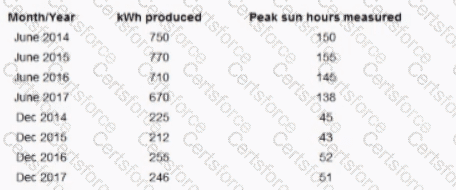A PV array is tested with an IV curve tracer. The fill factor is 0.70, lower than the expected 0.80. What does this indicate?
A AWG THWN-2 PV output conductors from two PV arrays are run in the same 3 in, conduit to their respective functionally grounded inverters in the building. The three PV source circuits are each protected by a 15A fuse in the combiner box at the array. The conduit, which is strapped directly to the roof, is exposed to design temperatures of 140’ F (60’ C) during its 30 ft.
Exposed run. What is the MAXIMUM current carrying capability value of the PV output conductors?
A homeowner is concerned that a 6kWdc PV system might be experiencing a performance issue. The homeowner has noticed what appears to be declining production. The installer analyzes the following data acquisition system (DAS) results for each year since the installation:

Given the data, which is the MOST likely conclusion to draw?
A dwelling has a 200A main load center with a 150 main breaker. Which of the following is the MOST powerful 240V inverter that can be installed in the house using the existing main panelboard with a backfed breaker?
When doing initial inspections on a PV system that was installed using racking that is not compliant with UL.2703, an inspector should pay special attention to which electrical attribute?
A PV system is installed in a location with an average annual ambient temperature of 30°C. If the module’s NOCT (Nominal Operating Cell Temperature) is 45°C, what is the expected cell temperature under standard operating conditions (800 W/m² irradiance)?
A PV module has a NOCT of 47°C. At 1000 W/m² and 35°C ambient, what is the cell temperature?
A system’s performance ratio (PR) is calculated as 0.85. If the array capacity is 10 kW and PSH is 5, what is the daily AC output?